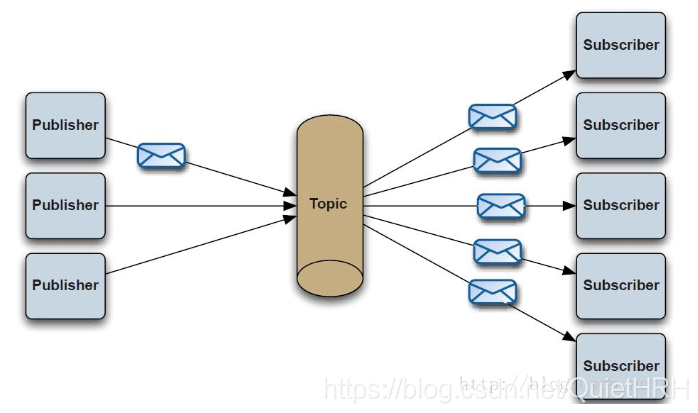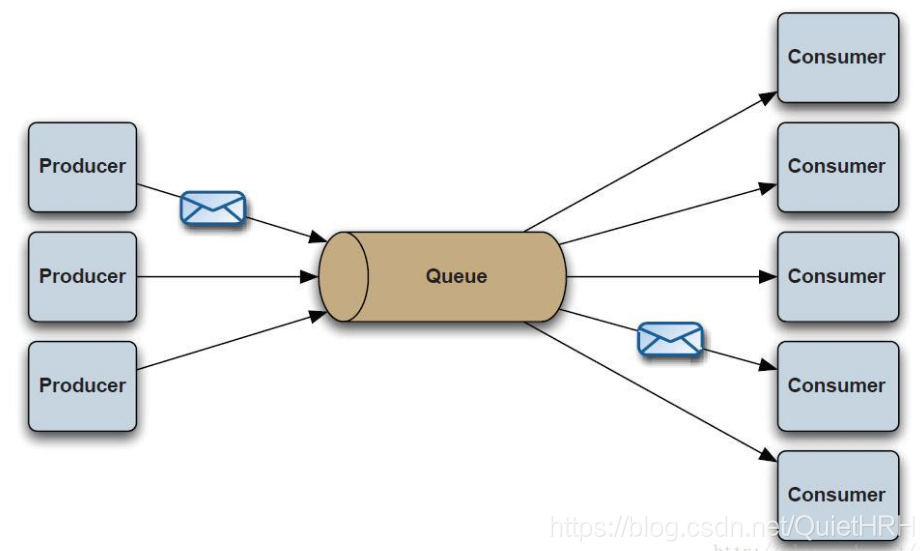JMS消息中间件ActiveMQ
降低模块间的耦合的解决方案
RPC 适用于同步更新 – dubbo springCloud
消息中间件 适用于异步更新 ActiveMQ RabbitMQ ZeroMQ Kafka…
1. 消息中间件
耦合越多,维护工作就越困难。那么如果改善系统模块调用关系、减少模块之间的耦合呢?
消息中间件就是一种解决方案。
消息中间件利用高效可靠的消息传递机制进行平台无关的数据交流,并基于数据通信来进行分布式系统的集成。通过提供消息传递和消息排队模型,它可以在分布式环境下扩展进程间的通信。对于消息中间件,常见的角色大致也就有Producer(生产者)、Consumer(消费者)
2.JMS
JMS(Java Messaging Service)是Java平台上有关面向消息中间件的技术规范,类似于JDBC,是一系列的接口,具体实现由厂商实现
消息是 JMS 中的一种类型对象,由两部分组成:报头和消息主体。报头由路由信息以及有关该消息的元数据组成。消息主体则携带着应用程序的数据或有效负载。
JMS 定义了五种不同的消息正文格式,以及调用的消息类型,允许你发送并接收以一些不同形式的数据,提供现有消息格式的一些级别的兼容性。
- TextMessage–一个字符串对象
- MapMessage–一套名称-值对
- ObjectMessage–一个序列化的 Java 对象
- BytesMessage–一个字节的数据流
- StreamMessage – Java 原始值的数据流
3.JMS传递类型
点对点(PTP point-to-point)
一个生产者对应一个消费者
即生产者发送一个消息,只能有一个消费者收到,如果发送消息后,无消费者存在,则将消息存到消息队列中(queue),一直等待消费者消费,当消费者消费后,队列收到信号,将消息删除
发布/订阅模式(pub/sub Publist/subscribe)
一个生产者对应多个消费者
生产者发送一个消息,所有消费者都可接收到,如果发送消息后,无消费者存在,主题(topic)不会缓存消息,与点对点的queue不同

4.activeMQ访问地址
http://ip:8161/ 即可进入ActiveMQ管理页面 管理界面端口为8161
http://ip:61616/ 发送接收消息端口为61616
ActiveMQ demo
<dependency>
<groupId>org.apache.activemq</groupId>
<artifactId>activemq-client</artifactId>
<version>5.13.4</version>
</dependency>
1. 生产者
//1.创建连接工厂
ConnectionFactory connectionFactory=new ActiveMQConnectionFactory("tcp://192.168.25.135:61616");
//2.获取连接
Connection connection = connectionFactory.createConnection();
//3.启动连接
connection.start();
//4.获取session (参数1:是否启动事务,参数2:消息确认模式)
Session session = connection.createSession(false, Session.AUTO_ACKNOWLEDGE);
//5.创建队列对象 点对点模式
Queue queue = session.createQueue("test-queue");
//6.创建消息生产者(点对点)
MessageProducer producer = session.createProducer(queue);
/*
//5.创建主题对象 发布/订阅模式
Topic topic = session.createTopic("test-topic");
//6.创建消息生产者
MessageProducer producer = session.createProducer(topic);
*/
//7.创建消息
TextMessage textMessage = session.createTextMessage("欢迎来到神奇的品优购世界");
//8.发送消息
producer.send(textMessage);
//9.关闭资源
producer.close();
session.close();
connection.close();
第4步创建session 的两个参数:
第1个参数 是否使用事务
第2个参数 消息的确认模式
- AUTO_ACKNOWLEDGE = 1 自动确认
- CLIENT_ACKNOWLEDGE = 2 客户端手动确认
- DUPS_OK_ACKNOWLEDGE = 3 自动批量确认
- SESSION_TRANSACTED = 0 事务提交并确认
2.消费者
//1.创建连接工厂
ConnectionFactory connectionFactory=new ActiveMQConnectionFactory("tcp://192.168.25.135:61616");
//2.获取连接
Connection connection = connectionFactory.createConnection();
//3.启动连接
connection.start();
//4.获取session (参数1:是否启动事务,参数2:消息确认模式)
Session session = connection.createSession(false, Session.AUTO_ACKNOWLEDGE);
//5.创建队列对象 点对点
Queue queue = session.createQueue("test-queue");
//6.创建消息消费
MessageConsumer consumer = session.createConsumer(queue);
/*
//5.创建主题对象 发布订阅
Topic topic = session.createTopic("test-topic");
//6.创建消息消费
MessageConsumer consumer = session.createConsumer(topic);
*/
//7.监听消息
consumer.setMessageListener(new MessageListener() {
public void onMessage(Message message) {
TextMessage textMessage=(TextMessage)message;
try {
System.out.println("接收到消息:"+textMessage.getText());
} catch (JMSException e) {
// TODO Auto-generated catch block
e.printStackTrace();
}
}
});
//8.等待键盘输入 使主线程卡住 一直监听MQ
System.in.read();
//9.关闭资源
consumer.close();
session.close();
connection.close();
Spring整合JMS
生产者xml
- ActiveMQConnectionFactory
- SingleConnectionFactory
- JmsTemplate
- ActiveMQQueue / ActiveMQTopic
消费者xml
- ActiveMQConnectionFactory
- SingleConnectionFactory
- ActiveMQQueue / ActiveMQTopic
- DefaultMessageListenerContainer
1.生产者applicationContext-jms-producer.xml
<?xml version="1.0" encoding="UTF-8"?>
<beans xmlns="http://www.springframework.org/schema/beans"
xmlns:xsi="http://www.w3.org/2001/XMLSchema-instance"
xmlns:context="http://www.springframework.org/schema/context"
xsi:schemaLocation="http://www.springframework.org/schema/beans http://www.springframework.org/schema/beans/spring-beans.xsd http://www.springframework.org/schema/context http://www.springframework.org/schema/context/spring-context.xsd">
<context:component-scan base-package="com.pyg.shop.controller"></context:component-scan>
<!-- 真正可以产生Connection的ConnectionFactory,由对应的 JMS服务厂商提供-->
<bean id="targetConnectionFactory" class="org.apache.activemq.ActiveMQConnectionFactory">
<property name="brokerURL" value="tcp://192.168.25.135:61616"/>
</bean>
<!-- Spring用于管理真正的ConnectionFactory的ConnectionFactory -->
<bean id="connectionFactory" class="org.springframework.jms.connection.SingleConnectionFactory">
<!-- 目标ConnectionFactory对应真实的可以产生JMS Connection的ConnectionFactory -->
<property name="targetConnectionFactory" ref="targetConnectionFactory"/>
</bean>
<!-- Spring提供的JMS工具类,它可以进行消息发送、接收等 -->
<bean id="jmsTemplate" class="org.springframework.jms.core.JmsTemplate">
<!-- 这个connectionFactory对应的是我们定义的Spring提供的那个ConnectionFactory对象 -->
<property name="connectionFactory" ref="connectionFactory"/>
</bean>
<!--这个是队列目的地,点对点的 文本信息-->
<bean id="queueTextDestination" class="org.apache.activemq.command.ActiveMQQueue">
<constructor-arg value="queue_text"/>
</bean>
<!--这个是订阅模式 文本信息-->
<bean id="topicTextDestination" class="org.apache.activemq.command.ActiveMQTopic">
<constructor-arg value="topic_text"/>
</bean>
</beans>
2.生产者类
@Component
public class QueueProducer {
@Autowired
private JmsTemplate jmsTemplate;
@Autowired
private Destination queueTextDestination;
@Autowired
private Destination topicTextDestination;
/**
* 发送文本消息
* @param text
*/
public void sendTextMessage(final String text){
jmsTemplate.send(queueTextDestination, new MessageCreator() {
public Message createMessage(Session session) throws JMSException {
return session.createTextMessage(text);
}
});
}
/**
* 发送文本消息
* @param text
*/
public void sendTextMessage2(final String text){
jmsTemplate.send(topicTextDestination, new MessageCreator() {
public Message createMessage(Session session) throws JMSException {
return session.createTextMessage(text);
}
});
}
}
3.消费者applicationContext-jms-consumer.xml
<?xml version="1.0" encoding="UTF-8"?>
<beans xmlns="http://www.springframework.org/schema/beans"
xmlns:xsi="http://www.w3.org/2001/XMLSchema-instance"
xmlns:context="http://www.springframework.org/schema/context"
xsi:schemaLocation="http://www.springframework.org/schema/beans http://www.springframework.org/schema/beans/spring-beans.xsd http://www.springframework.org/schema/context http://www.springframework.org/schema/context/spring-context.xsd">
<!-- 真正可以产生Connection的ConnectionFactory,由对应的 JMS服务厂商提供-->
<bean id="targetConnectionFactory" class="org.apache.activemq.ActiveMQConnectionFactory">
<property name="brokerURL" value="tcp://192.168.25.135:61616"/>
</bean>
<!-- Spring用于管理真正的ConnectionFactory的ConnectionFactory -->
<bean id="connectionFactory" class="org.springframework.jms.connection.SingleConnectionFactory">
<!-- 目标ConnectionFactory对应真实的可以产生JMS Connection的ConnectionFactory -->
<property name="targetConnectionFactory" ref="targetConnectionFactory"/>
</bean>
<!--这个是队列目的地,点对点的 文本信息-->
<bean id="queueTextDestination" class="org.apache.activemq.command.ActiveMQQueue">
<constructor-arg value="queue_text"/>
</bean>
<!-- 我的监听类 -->
<bean id="myMessageListener" class="cn.hrh.demo.MyMessageListener"></bean>
<!-- 消息监听容器 -->
<bean class="org.springframework.jms.listener.DefaultMessageListenerContainer">
<property name="connectionFactory" ref="connectionFactory" />
<property name="destination" ref="queueTextDestination" />
<property name="messageListener" ref="myMessageListener" />
</bean>
<!--这个是主题目的地,发布/订阅的 文本信息-->
<bean id="topicTextDestination" class="org.apache.activemq.command.ActiveMQTopic">
<constructor-arg value="topic_text"/>
</bean>
<!-- 我的监听类 -->
<bean id="myMessageListener2" class="cn.hrh.demo.MyMessageListener"></bean>
<!-- 消息监听容器 -->
<bean class="org.springframework.jms.listener.DefaultMessageListenerContainer">
<property name="connectionFactory" ref="connectionFactory" />
<property name="destination" ref="topicTextDestination" />
<property name="messageListener" ref="myMessageListener2" />
</bean>
</beans>
4.消费者类
@Component
public class MyMessageListener implements MessageListener {
public void onMessage(Message message) {
TextMessage textMessage=(TextMessage)message;
try {
System.out.println("接收到消息:"+textMessage.getText());
} catch (JMSException e) {
e.printStackTrace();
}
}
}
@Component
public class MyMessageListener2 implements MessageListener {
public void onMessage(Message message) {
TextMessage textMessage=(TextMessage)message;
try {
System.out.println("接收到消息:"+textMessage.getText());
} catch (JMSException e) {
e.printStackTrace();
}
}
}


























 219
219

 被折叠的 条评论
为什么被折叠?
被折叠的 条评论
为什么被折叠?








